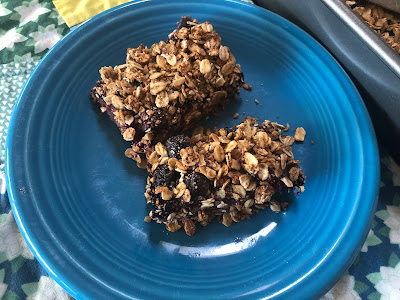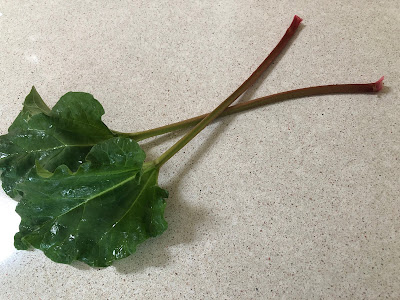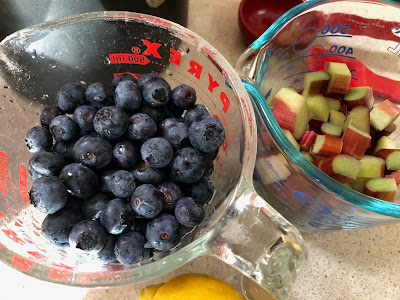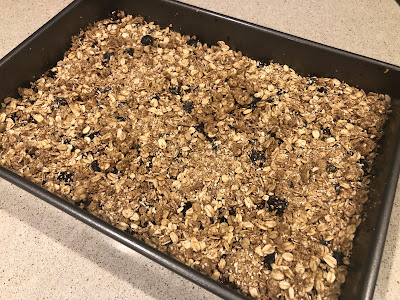
Recipe: Blueberry meets rhubarb at the breakfast table
 |
|
These "bluebarb" bars are just lightly sweet. (Photos:
Kathy Morrison)
|
My little rhubarb plant finally had stalks to harvest. They were skinny, but long enough -- a plant grown from a tiny seedling purchased a few years ago at an American River College plant sale.
Rhubarb is not the easiest crop to grow in our climate, but this potted rhubarb has hung in there, protected by the shade of my little peach tree.
And I thought "now or never" for harvesting this year, with the real summer weather approaching. The plant will soon follow its perennial schedule, dying back in heat and re-emerging next winter.
But two stalks weren't going to do much in any baked good, so I augmented them with one large purchased rhubarb stalk. Then I found a recipe that combines rhubarb with blueberries (which are just coming into season locally) in a no-dairy, no-egg oat bar. Just a little sweet, with a whole-grain base -- perfect for breakfast.
Note: The amount of fruit is variable. I started with about 3 1/2 cups total, then added another 1/2 cup of blueberries when I realized the fruit was going to be spread a little thin. The recipe as baked could have taken another 1/2 cup of either fruit easily, so the amounts listed below reflect that.
 |
|
They're thin but they're homegrown: My rhubarb stalks.
Note: Never eat the rhubarb leaves, or let pets eat them --
they're poisonous. Compost or discard them.
|
'Bluebarb' breakfast bars
Makes 24 bars
Ingredients:
1 teaspoon coconut oil (for pan)
Filling:
2-1/2 to 3 cups blueberries
1 to 1-1/2 cups chopped rhubarb
1/3 cup honey or maple syrup
Zest and juice of 1 large lemon (about 4 tablespoons juice)
1/8 cup water plus 1 tablespoon, divided
1/2 tablespoon vanilla extract
1 tablespoon cornstarch or arrowroot powder
Oat crust and top:
4 cups old-fashioned rolled oats
1 teaspoon nutmeg
2-1/2 teaspoons cinnamon
2 teaspoons baking powder
 |
|
The fruit as prepared: The rhubarb was chopped into chunks about
the same size as the blueberries, which were large.
|
1/2 teaspoon fine salt
2/3 cup unsweetened applesauce
2 tablespoons coconut oil (in liquid form); up to 1/2 tablespoon more if needed
1 tablespoon vanilla extract
Instructions:
Preheat oven to 375 degrees. Grease a 9-by-12-inch baking pan with the 1 teaspoon of coconut oil.
Combine the fruit, honey (or syrup), lemon zest, lemon juice, 1/8 cup water and vanilla in a medium saucepan. In a small bowl or measuring cup, combine the cornstarch and the 1 tablespoon of water into a slurry. Heat the fruit mixture over medium-high heat until it has a strong bubble going. Remove from heat and stir in the cornstarch/water slurry until well combined. Set aside to cool.
Put 2 cups of the rolled oats in a food processor or blender and blend until the oats are finely ground. Pour them into a large bowl along with the remaining oats, the nutmeg, cinnamon, baking powder and salt. Stir together, then add the applesauce, 2 tablespoons coconut oil and the vanilla. Mix together to get everything consistently blended. (Clean hands work best for mixing here.) Add a little more coconut oil if the mixture seems too dry. It shouldn't be wet when you're done, but you should be able to create small clumps.
 |
| The bars are layered and ready to go in the oven. |
Press half the oat mixture firmly and evenly into the greased pan. Spread the fruit mixture evenly over the crust, then crumble the remaining oat mixture over the fruit.
Bake 30 to 35 minutes. Allow pan to cool completely before cutting into bars.
Leftovers should be wrapped and refrigerated. (Wrap them individually for a quick snack.)
Variation: Substitute up to 3/4 cup of chopped nuts for an equal part of the whole rolled oats.
Comments
0 comments have been posted.Sacramento Digs Gardening to your inbox.
Food in My Back Yard Series
May 6: Maintain soil moisture with mulch for garden success
April 29: What's (already) wrong with my tomato plants?
April 22: Should you stock up on fertilizer? (Yes!)
April 15: Grow culinary herbs in containers
April 8: When to plant summer vegetables
April 1: Don't be fooled by these garden myths
March 25: Fertilizer tips: How to 'feed' your vegetables for healthy growth
March 18: Time to give vegetable seedlings some more space
March 11: Ways to win the fight against weeds
March 4: Potatoes from the garden
Feb. 25: Plant a fruit tree now -- for later
Feb. 18: How to squeeze more food into less space
Feb. 11: When to plant? Consider staggering your transplants
Feb. 4: Starting in seed starting
Sites We Like
Garden Checklist for week of May 11
Make the most of the lower temperatures early in the week. We’ll be back in the 80s by Thursday.
* Plant, plant, plant! It’s prime planting season in the Sacramento area. Time to set out those tomato transplants along with peppers and eggplants. Pinch off any flowers on new transplants to make them concentrate on establishing roots instead of setting premature fruit.
* Direct-seed melons, cucumbers, summer squash, corn, radishes, pumpkins and annual herbs such as basil.
* Harvest cabbage, lettuce, peas and green onions.
* In the flower garden, direct-seed sunflowers, cosmos, salvia, zinnias, marigolds, celosia and asters. (You also can transplant seedlings for many of the same flowers.)
* Plant dahlia tubers.
* Transplant petunias, marigolds and perennial flowers such as astilbe, columbine, coneflowers, coreopsis, dahlias, rudbeckia and verbena.
* Keep an eye out for slugs, snails, earwigs and aphids that want to dine on tender new growth.
* Feed summer bloomers with a balanced fertilizer.
* For continued bloom, cut off spent flowers on roses as well as other flowering plants.
* Add mulch to the garden to maintain moisture. Mulch also cuts down on weeds. But don’t let it mound around the stems or trunks of trees or shrubs. Leave about a 6-inch-to-1-foot circle to avoid crown rot or other problems.
* Remember to weed! Pull those nasties before they set seed.
* Water early in the day and keep seedlings evenly moist.